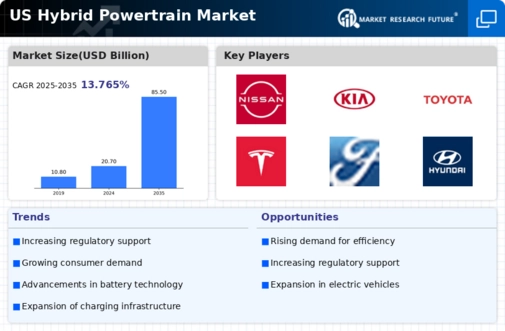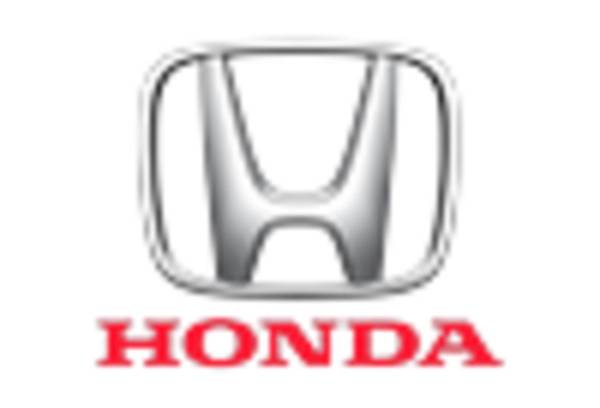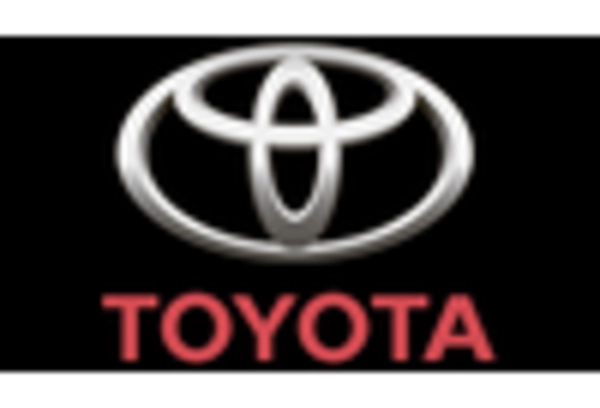Increasing Fuel Prices
The hybrid powertrain market is likely to benefit from the rising fuel prices in the US. As consumers face higher costs at the pump, the demand for fuel-efficient vehicles, particularly hybrids, is expected to surge. Historical data indicates that when fuel prices increase by 10%, the sales of hybrid vehicles tend to rise by approximately 15%. This correlation suggests that economic factors play a crucial role in consumer purchasing decisions. Consequently, automakers are likely to respond by expanding their hybrid offerings, thereby enhancing the overall growth of the hybrid powertrain market. The economic landscape appears to favor the adoption of hybrid technologies as consumers seek to mitigate fuel expenses.
Shifts in Consumer Preferences
Shifts in consumer preferences are significantly impacting the hybrid powertrain market. As awareness of environmental issues grows, consumers are increasingly seeking sustainable transportation options. Surveys indicate that nearly 60% of potential car buyers in the US express a preference for vehicles with lower emissions. This trend is prompting automakers to prioritize hybrid models in their product lines. Additionally, the perception of hybrids as technologically advanced and cost-effective alternatives to traditional vehicles is likely to enhance their appeal. As consumer preferences continue to evolve, the hybrid powertrain market is poised for growth, driven by a demand for greener and more efficient transportation solutions.
Rising Fuel Efficiency Standards
The hybrid powertrain market is experiencing a notable shift due to the implementation of stringent fuel efficiency standards in the US. Regulatory bodies have established ambitious targets aimed at reducing greenhouse gas emissions from vehicles. As a result, automakers are increasingly investing in hybrid technologies to comply with these regulations. The Corporate Average Fuel Economy (CAFE) standards, which require an average fuel economy of 54.5 mpg by 2025, are driving manufacturers to innovate and enhance their hybrid powertrains. This regulatory pressure is likely to propel the hybrid powertrain market forward, as companies seek to meet compliance while also appealing to environmentally conscious consumers.
Government Incentives for Hybrid Vehicles
Government incentives are playing a pivotal role in shaping the hybrid powertrain market. Various federal and state programs offer tax credits, rebates, and grants to consumers who purchase hybrid vehicles. For instance, the federal tax credit can reach up to $7,500 for qualifying hybrid models, making them more financially accessible to consumers. These incentives not only encourage the adoption of hybrid vehicles but also stimulate manufacturers to invest in hybrid technology development. As the government continues to support the transition to cleaner transportation, the hybrid powertrain market is expected to experience sustained growth, driven by both consumer interest and manufacturer commitment.
Technological Innovations in Powertrain Design
Innovations in powertrain design are significantly influencing the hybrid powertrain market. Advances in electric motor technology, battery management systems, and energy recovery systems are enhancing the performance and efficiency of hybrid vehicles. For instance, the integration of lightweight materials and improved aerodynamics is enabling manufacturers to produce more efficient hybrid models. According to recent data, the efficiency of hybrid powertrains has improved by approximately 20% over the past five years, making them more appealing to consumers. As these technological advancements continue to evolve, they are expected to further stimulate growth in the hybrid powertrain market, attracting both manufacturers and consumers alike.

















Leave a Comment